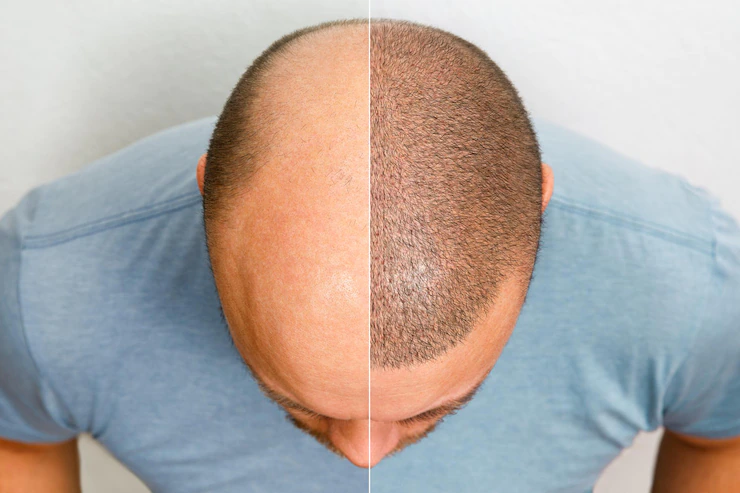HAIR TRANSPLANTATION
Follicular Unit Excision (FUE)
Follicular Unit Transplant (FUT)
Body Hair Follicular Unit Excision
Beard/Eyebrow/Eyelash
Transplants
FUE, Follicular Unit Excision and FUT, Follicular Unit Transplant are the two main transplant techniques.
At ALOVIA we offer both these treatments and therefore can advise which one is best for you.
FUE and FUT are different surgical procedures and during your consultation, your surgeon will recommend the procedure that is right for you.
Know more about FUE
Know more about FUT

Follicular Unit Excision
Of the two main hair transplant techniques, Follicular Unit Excision (FUE) is the least surgically invasive. Strong, healthy hair is removed from a donor zone (usually the back of the head, where hair growth is normally unaffected by hair loss). The hairs are removed from the donor zone in small natural groupings or follicular units of between one and four hairs. These units are approximately 0.75 – 1mm wide, and are carefully removed using a surgical tool called a micropunch.
The follicles are checked and cleaned under magnification. This is critical to ensure the future success of the follicle. The follicular units are then stored in a special holding solution, while the surgeon creates the recipient sites in the areas of hair loss. The whole process is usually completed in eight hours, although more extensive transplants may require two sessions.
Hair falls out of transplanted follicles after around 30 days, with natural regrowth occurring from 3 months. Full regrowth is expected after 12-18 months.
FUE Hair Transplant Procedure
We will shave your donor hair and in preparation for hair extraction (a non-shave option is available on a suitable candidate). We’ll administer local anaesthetic and sedatives before your Hair Dr surgeon begins performing the FUE donor hair extraction. The hair units are then separated into natural groups of 1-4 hairs, cleaned and maintained in a bespoke “holding solution”. Your Hair Dr surgeon will then create the custom-made recipient sites, also known as slits, where the hair units will be placed starting from the hairline and working back. Skilled technicians will work alongside your Hair Dr surgeon to carefully place each hair units/follicular units creating natural-looking results.
Following your FUE hair transplant surgery you will receive a post-op treatment, medications and a full after-care plan to ensure your hair transplant journey is seamless.
Follicular Unit Transplant
Follicular Unit Transplant (FUT) is also known as ‘the strip technique’. It requires a much greater degree of surgical expertise to be performed successfully. A small strip of skin is removed from the back or sides of the head, containing the donor hair. This allows many hairs to be removed simultaneously. The hairs are then removed from the strip in follicular units, cleaned and placed into the holding solution.
The surgeon then creates the recipient sites in the areas of hair loss, and implants the units in the same way as the FUE procedure.
Sutures are required in the donor area, to be removed after 10-14 days. Like most comparable surgical procedures, exercise or vigorous physical activity is discouraged for 30 days after the transplant.
FUT Hair Transplant Procedure
The donor zone will be measured and shaved, only within the area of the strip. Local anaesthetic and sedative is are administered reducing any stress or anxiety you may have. The Hair Dr surgeon will perform the FUT hair removal from the donor followed by suturing the area. The hair follicles are then divided into groups of 1-4 hairs, trimmed, cleaned and stored in a holding solution. The Hair Dr surgeon will then create the custom-made recipient sites, also known as slits within the areas of hair loss, to be treated. The technician team, alongside the Hair Dr surgeon, will finish off the procedure, placing the hair units into the recipient sites.
FUT only removes hair from a small isolated area, resulting in an easily hidden linear scar, even with short hairstyles. Our closure techniques allow your hair to grow through the suture line, camouflaging the scar further.
Following your FUT hair transplant surgery, you will receive a post-op treatment, medications and a full after-care plan to ensure your hair transplant journey is seamless.
Body Hair Follicle Unit Excision
In some circumstances, we’ll recommend Body Hair Follicular Unit Excision (BHFUE).
Hair is extracted using the FUE approach.
What is BHFUE?
BHFUE is an advanced level of hair transplant used to expand the donor area. Body hair removal is demanding to perform as often the areas of the body are very pliable resulting in skin laxity making hair removal more difficult.
When would we recommend a BHFU Excision?
BHFUE provides a larger ‘hair bank’, greatly increasing the amount of
donor hair that can be harvested. This can be useful if there are less
suitable donor sites on the scalp to choose from.
BHFUE requires body hair to be sufficiently matched in curl, colour and
coarseness to the area of hair loss.
about BHFUE
Beard/Eyebrow/Eyelash Transplants
Modern transplant techniques make it possible for us to transplant hair to the beard, eyelashes, and eyebrow areas. Either FUE or FUT techniques can be used for these procedures. Facial hair transplants can take from three to eight hours, depending on the extent of the transplant.
Donor hair must be carefully matched in curl, colour and coarseness – consequently, prices for these procedures are only available on request.
Beard Transplants
Beard transplants are requested by patients who wish for either fuller beard hair, or a more even growth pattern. Beard transplants can also be used to cover acne scars or other facial scarring. The donor areas used for beard transplants are commonly found on the scalp or chest.
Eyebrow Transplants
Eyebrow transplants can be required as a result of overplucking, scarring and chemical burns, as well as alopecia. Eyebrow transplants can be used to increase the definition and density, or alter the shape of the eyebrow. Common donor areas include the scalp, the legs, and the arms.
Eyelash Transplants
An eyelash transplant uses different placement techniques than other hair transplants, requiring a higher level of surgical precision. As a result, sessions are shorter with 24 to 40 eyelashes implanted over a three-hour period.
FAQs:-
The good news is, no — a hair transplant is not painful. At the time of the procedure, the area of your scalp that the surgeon will be focusing on will be numbed with a local anesthetic, so while you may feel a little pressure or movement sensations during the procedure, it shouldn’t be painful.
A hair transplant is a good option for people who can afford the high cost of the procedure and haven’t found success from treatments like minoxidil or Rogaine. Hair transplant surgery is relatively low risk compared with other surgeries, but it isn’t without risks. There is also always the possibility that your hair regrowth may be minimal.
REACH US
2-37/74&75/2 CROWN COURT, 2nd FLOOR, PLOT NO: 74 & 75 VINAYAK NAGAR, GACHIBOWLI, HYDERABAD-500032.
